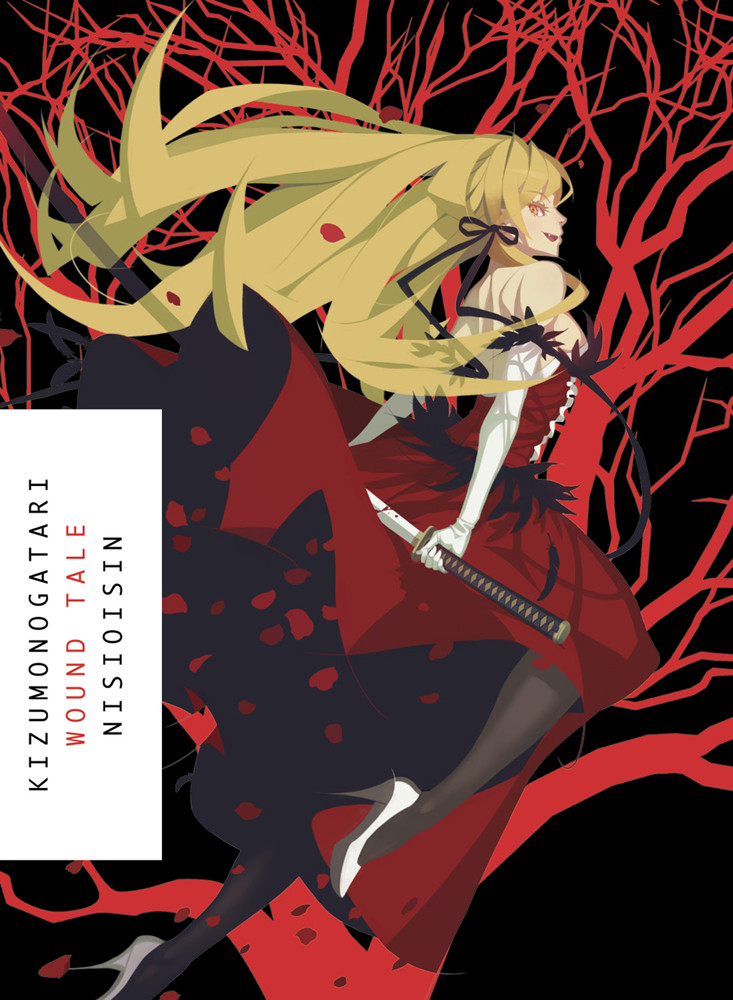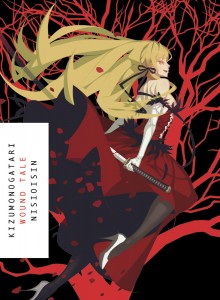By NISIOISIN. Released in Japan by Kodansha. Released in North America by Vertical, Inc. Translated by Ko Ransom.
As I mentioned in my prior review of Kizumonogatari, this volume originally came first, but at the request of the agent and author they decided to do Kizumonogatari, which is first chronologically, followed by this series if Kizu sold well. Which it apparently did, as we now have not only Bakemonogatari in 3 parts coming to North America, but also its sequel Nisemonogatari (in 2 parts). This release is in three parts to match the Japanese digital re-release, and contains the first two stories in the series, Hitagi Crab and Mayoi Snail. We are reintroduced to Meme Oshino, our specialist in the supernatural; Tsubasa Hanekawa, our specialist in being the perfect class president; and Koyomi Araragi, our specialist in tsukkomi… and also finding trouble and women.
There are a few surprises in this volume. First of all, we not only get references to what happened in Kizumonogatari, but also something that happened to Hanekawa during Golden Week, which has several hints (involving a “sex cat”) but no actual explanation. More importantly, if you’d only read Kizu you may have assumed that Hanekawa was the obvious girl that Araragi was going to end up with. Thus you may be thrown off to be introduced to Hitagi Senjogahara here, who not only manages to make a much bigger impact on Araragi from the get-go, but by the end of the volumes has confessed to him and become his girlfriend. Given that the Monogatari Series uses many, many common tropes of the harem series – most deliberately – it’s somewhat startling to see the “first girl win” immediately. But then, by sheer force of personality Senjogahara is amazing. She’s seemingly rude, uncaring and vicious, but her backstory certainly explains why that would be the case, and once things turn for the better, she’s still rude, but the uncaring and vicious are replaced by a surprising sensitivity.
The other story in this volume involves Mayoi Hachikuji, a young elementary schoolgirl who seems to be beset by a spirit that keeps her from finding her way anywhere. As with most stories in Monogatari, the truth is far more complicated. I’m not sure whether Nisio wrote this series from the start intending it to become an anime, but if he did it does not surprise me that he adds a “loli” character straight off the bat. That said, the series is a lot more overt about calling attention to Hachikuji’s young age and “developing” body – both in adding fanservice and showing off how creepy it really is. Nisioisin’s series have a large amount of having their cake and eating it too, and this is no exception.
If anything throws off the casual reader besides the token loli, it may be the crushing verbiage. Due to being split into three, this is a much shorter book than Kizu, but it still feels pretty long, mostly due to the endless dialogue which meanders on and off point at will, and is filled with subtle references, kanji puns, explanation of kanji puns, and boke and tsukkomi routines. It’s a credit to the translator that this rarely feels awkward or out of place, and a surprising amount of the original is kept, using a very deft touch. (Note to suspicious Americans: yes, Araragi did mention the 90s sitcom Full House in the Japanese version.) One exception that I think many people were looking for is the ‘tore’ confession response by Araragi, which is adapted into English somewhat awkwardly but I can see why there, you don’t want to kill the most heartwarming scene with more kanji discussion. Well, unless you’re a Nisio fan.
To sum up, if you like amusing characters, fun dialogue, and endless scenes of Araragi shouting comebacks, this is a great volume to get. You can also see just how much the anime cut out to make things fit – check out all the conversations we missed! And stay tuned, as Part 2 will introduce the perverse Kanbaru and the polarizing Sengoku.



